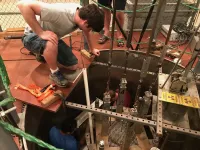Harnessing the dark side
Optical singularities could be used for a wide range of applications from super resolution imaging to optical trapping
2021-07-12
(Press-News.org) When we think about singularities, we tend to think of massive black holes in faraway galaxies or a distant future with runaway AI, but singularities are all around us. Singularities are simply a place where certain parameters are undefined. The North and South Pole, for example, are what's known as coordinate singularities because they don't have a defined longitude.
Optical singularities typically occur when the phase of light with a specific wavelength, or color, is undefined. These regions appear completely dark. Today, some optical singularities, including optical vortices, are being explored for use in optical communications and particle manipulation but scientists are just beginning to understand the potential of these systems. The question remains -- can we harness darkness like we harnessed light to build powerful, new technologies?
Now, researchers from the Harvard John A. Paulson School of Engineering and Applied Sciences (SEAS) have developed a new way to control and shape optical singularities. The technique can be used to engineer singularities of many shapes, far beyond simple curved or straight lines. To demonstrate their technique, the researchers created a singularity sheet in the shape of a heart.
"Conventional holography techniques are good at shaping light, but struggle to shape the darkness," said Federico Capasso, the Robert L. Wallace Professor of Applied Physics and Vinton Hayes Senior Research Fellow in Electrical Engineering at SEAS and senior author of the paper. "We have demonstrated on-demand singularity engineering, which opens up a vast set of possibilities in wide-ranging fields, from super-resolution microscopy techniques to new atomic and particle traps."
The research is published in Nature Communications.
Capasso and his team used flat metasurfaces with precisely-shaped nanopillars to shape the singularities.
"The metasurface tilts the wavefront of light in a very precise manner over a surface so that the interference pattern of the transmitted light produces extended regions of darkness," said Daniel Lim, a graduate student at SEAS and first author of the paper. "This approach allows us to precisely engineer dark regions with remarkably high contrast."
Engineered singularities could be used to trap atoms in dark regions. These singularities could also improve super high-resolution imaging. While light can only be focused to regions about half a wavelength (the diffraction limit) in size, darkness has no diffraction limit, meaning it can be localized to any size. This allows darkness to interact with particles over length scales much smaller than the wavelengths of light. This could be used to provide information on not only the size and the shape of the particles but their orientation as well.
Engineered singularities could extend beyond waves of light to other types of waves.
"You can also engineer dead zones in radio waves or silent zones in acoustic waves," said Lim. "This research points to the possibility of designing complex topologies in wave physics beyond optics, from electron beams to acoustics," said Lim.
The Harvard Office of Technology Development has protected the intellectual property relating to this project and is exploring commercialization opportunities.
INFORMATION:
The research was co-authored by Joon-Suh Park, Maryna L. Meretska, and Ahmed H. Dorrah. It was supported in part by the Air Force Office of Scientific Research under award number FA9550- 19-1-0135 and ?by the Office of Naval Research (ONR) under award number N00014-20-1-2450.
[Attachments] See images for this press release:

ELSE PRESS RELEASES FROM THIS DATE:
2021-07-12
Los Alamos, N.M., July 12, 2021--For the first time, the long-theorized neutron-clustering effect in nuclear reactors has been demonstrated, which could improve reactor safety and create more accurate simulations, according to a new study recently published in the journal Nature Communications Physics.
"The neutron-clustering phenomenon had been theorized for years, but it had never been analyzed in a working reactor," said Nicholas Thompson, an engineer with the Los Alamos Advanced Nuclear Technology Group. "The findings indicate that, as neutrons fission and create more neutrons, some go on to form large lineages of clusters while others quickly die off, resulting in so-called 'power tilts,' ...
2021-07-12
(Boston)--Despite the availability of numerous effective birth control methods, more than 40 percent of pregnancies worldwide are unintended. In addition to contributing significantly to population growth, unintended pregnancies can have pronounced adverse effects on maternal physical, mental and economic wellbeing.
Researchers from Boston University School of Medicine (BUSM) and ZabBio (San Diego, CA) have developed an anti-sperm monoclonal antibody, the Human Contraception Antibody (HCA), which they found to be safe and possess potent sperm agglutination (clumping) and immobilization activity in laboratory tests.
"HCA appears to be suitable for contraceptive use and could be administered vaginally in a dissolvable film for a ...
2021-07-12
A research team from the University of Göttingen and the University of British Columbia (Canada) has investigated how people in five different countries react to various usages of genome editing in agriculture. The researchers looked at which uses are accepted and how the risks and benefits of the new breeding technologies are rated by people. The results show only minor differences between the countries studied - Germany, Italy, Canada, Austria and the USA. In all countries, making changes to the genome is more likely to be deemed acceptable when used in crops rather than in livestock. The study was published in Agriculture and Human Values.
Relatively new breeding technologies, such as CRISPR gene editing, have enabled a range of new opportunities for plant and animal breeding. ...
2021-07-12
The sensory cells in the inner ear and the touch receptors in the skin actually have a lot in common, according to a new study from the USC Stem Cell laboratory of Neil Segil published in the Proceedings of the National Academy of the Sciences (PNAS).
"There are striking similarities in the development of two types of specialized sensory cells: the so-called 'hair cells' that receive sound vibrations in the inner ear, and the Merkel cells that sense light touch at the surface of the skin," said Segil, who is a Professor in the Department of Stem Cell Biology and Regenerative Medicine, and the USC Tina and Rick Caruso Department of Otolaryngology ...
2021-07-12
The Lucinidae family, lucinids for short, comprises approximately 500 living species of bivalves. They are at least 400 million years old, according to fossil records, and have managed to colonize a wide variety of habitats, from beautiful beaches to the abyssal depths untouched by the sun over a kilometer below the sea surface. Their ability to thrive in a wide variety of habitats is made possible by their 'partner in crime', a sulfur-oxidizing bacterial symbiont that utilizes hydrogen sulfide, better known as 'rotten egg gas', as an energy source to power primary production. This process is not unlike photosynthesis used by plants, yet not dependent on sunlight, ...
2021-07-12
BOSTON - By implementing a long-term, prospective approach to the development of celiac disease, a collaborative group of researchers has identified substantial microbial changes in the intestines of at-risk infants before disease onset. Using advanced genomic sequencing techniques, MassGeneral Hospital for Children (MGHfC) researchers, along with colleagues from institutions in Italy and the University of Maryland, College Park, uncovered distinct preclinical alterations in several species, pathways and metabolites in children who developed celiac disease compared to at-risk children who did not develop celiac disease.
As part of the MGHfC Celiac Disease, Genomic, Microbiome and Metabolomic (CDGEMM) Study, researchers ...
2021-07-12
Communities trying to fight sea-level rise could inadvertently make flooding worse for their neighbors, according to a new study from the END ...
2021-07-12
Better treatments of HER2-positive breast cancer are closer at hand, thanks to new research by a team led by Université de Montréal professor Jean-François Côté at the cytoskeleton organization and cell-migration research unit of the UdeM-affiliated Montreal Clinical Research Institute.
Published in PNAS, the journal of the U.S. National Academy of Sciences, the new research by Marie-Anne Goyette, a doctoral student in Côté's laboratory, reveals a highly promising therapeutic target to counter the HER2-positive breast cancer.
In HER2-positive breast cancer, a gene called HER2 is expressed that promotes an aggressive form of the disease. Affecting 20 per cent of ...
2021-07-12
ITHACA, N.Y. - Traces of the gas phosphine point to volcanic activity on Venus, according to new research from Cornell University.
Last autumn, scientists revealed that phosphine was found in trace amounts in the planet's upper atmosphere. That discovery promised the slim possibility that phosphine serves as a biological signature for the hot, toxic planet.
Now Cornell scientists say the chemical fingerprint support a different and important scientific find: a geological signature, showing evidence of explosive volcanoes on the mysterious planet.
"The phosphine is not telling us about the biology ...
2021-07-12
AUSTIN, Texas -- Lead exposure in childhood may lead to less mature and less healthy personalities in adulthood, according to a new study lead by psychology researchers at The University of Texas at Austin.
The study, published in the Proceedings of the National Academy of Sciences, sampled more than 1.5 million people in 269 U.S. counties and 37 European nations. Researchers found that those who grew up in areas with higher levels of atmospheric lead had less adaptive personalities in adulthood -- lower levels of conscientiousness and agreeableness and higher levels of neuroticism.
"Links between lead exposure and personality traits are quite impactful, because we take our personalities with us everywhere," ...
LAST 30 PRESS RELEASES:
[Press-News.org] Harnessing the dark side
Optical singularities could be used for a wide range of applications from super resolution imaging to optical trapping




